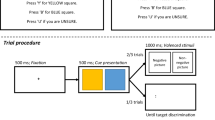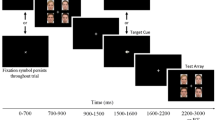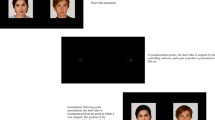Abstract
Cognitive models of social anxiety emphasize the role of an attentional shift toward cues related to somatic state in social anxiety. We examined attentional biases to somatic cues and cardiovascular reactivity in response to a social evaluative task. Participants performed an impromptu speech during which they received standardized negative evaluative comments. Participants then completed a dot-probe task with social evaluative, somatic, and anger-related words. Blood pressure (BP) and heart rate (HR) were assessed in 1-minute intervals during baseline, the speech task, and the dot-probe task. Despite the fact that a high social anxiety group reported higher levels of anxiety, high and low social anxiety groups did not differ in their speech task-evoked BP or HR responses. Furthermore, the high social anxiety group, compared to the low social anxiety group, exhibited greater attentional biases to somatic words, suggesting greater attention directed toward information pertinent to somatic arousal.


Similar content being viewed by others
Notes
A Social Anxiety X Word Type X Word Location X Probe Location GLM with participants’ raw RTs yielded a significant four-way interaction, F(2, 80) = 6.53, p = .002, \( \eta_{\text{p}}^2 = .{14} \)
References
Amir, N., McNally, R. J., Riemann, B. C., Burns, J., Lorenz, M., & Mullen, J. T. (1996). Suppression of the emotional Stroop effect by increased anxiety in patients with social phobia. Behaviour Research and Therapy, 34, 945–948.
Baggett, H. L., Saab, P. G., & Carver, C. S. (1996). Appraisal, coping, task performance, and cardiovascular responses during the evaluated speaking task. Personality and Social Psychology Bulletin, 22, 483–494.
Buckner, J. D., DeWall, C. N., Schmidt, N. B., & Maner, J. K. (2010). A tale of two threats: Social anxiety and attention to social threat as a function of social exclusion and non-exclusion threats. Cognitive Therapy and Research, 34, 449–455.
Clark, D. M., & Wells, A. (1995). A cognitive model of social phobia. In R. G. Heimberg, M. R. Liebowitz, D. A. Hope, & F. R. Schneier (Eds.), Social phobia: Diagnosis, assessment, and treatment (pp. 69–93). New York: Guilford Press.
Domschke, K., Stevens, S., Pfleiderer, B., & Gerlach, A. L. (2010). Interoceptive sensitivity in anxiety and anxiety disorders: An overview and integration of neurobiological findings. Clinical Psychology Review, 30, 1–11.
Edelmann, R. J., & Baker, S. R. (2002). Self-reported and actual physicological responses in social phobia. British Journal of Clinical Psychology, 41, 1–14.
Faunce, G. J., Mapledoram, P. K., & Job, R. F. S. (2004). Type A behavior pattern and attentional bias in relation to anger/hostility, achievement, and failure. Personality and Individual Differences, 36, 1975–1988.
Feldman, P. J., Cohen, S., Hamrick, N., & Lepore, S. J. (2004). Psychological stressm appraisal, emotion, and cardiovascular response in a public speaking task. Psychology and Health, 19(3), 353–368.
Gerlach, A. L., Mourlane, D., & Rist, F. (2004). Public and private heart rate feedback in social phobia: A manipulation of anxiety visibility. Cognitive Behaviour Therapy, 33, 36–45.
Gramer, M., & Sprintschnik, E. (2008). Social Anxiety and cardiovascular responses to an evaluative speaking task: The role of stressor anticipation. Personality and Individual Differences, 44, 371–381.
Hofmann, S. G., Moscovitch, D. A., & Kim, H.-J. (2006). Autonomic correlates of social anxiety and embarrassment in shy and non-shy individuals. Journal of Psychophysiology, 61, 134–142.
Keogh, E., Ellery, D., Hunt, C., & Hannent, I. (2001). Selective attentional bias for pain-related stimuli amongst pain fearful individuals. Pain, 91, 91–100.
MacLeod, C., & Mathews, A. (1988). Anxiety and the allocation of attention to threat. Quarterly Journal of Experimental Psychology, 40A, 653–670.
Mansell, W., Clark, D. M., & Ehlers, A. (2003). Internal versus external attention in social anxiety: an investigation using a novel paradigm. Behaviour Research and Therapy, 41, 555–572.
Mattick, R. P., & Clarke, J. C. (1998). Development and validation of measures of social phobia scrutiny fear and social interaction anxiety. Behaviour Research and Therapy, 36, 455–470.
Mauss, I. B., Wilhelm, F. H., & Gross, J. J. (2004). Is there less to social anxiety than meets the eye? Emotion experience, expression, and bodily responding. Cognition and Emotion, 18, 631–662.
Norton, G. R., Cox, B. J., Hewitt, P. L., & McLeod, L. (1997). Personality factors associated with generalized and non-generalized social anxiety. Personality and Individual Differences, 22, 655–660.
Pineles, S. L., & Mineka, S. (2005). Attentional biases to internal and external sources of potential threat in social anxiety. Journal of Abnormal Psychology, 114, 314–318.
Quartana, P. J., Bounds, S., Yoon, K. L., & Burns, J. W. (2010). Anger suppression predicts pain, emotional and cardiovascular responses to cold pressor pain. Annals of Behavioral Medicine, 39, 211–221.
Reiss, S. (1991). Expectancy model of fear, anxiety, and panic. Clinical Psychology Review, 11, 141–153.
Reiss, S., & McNally, R. J. (1985). Expectancy model of fear. In S. Reiss & R. R. Bootzin (Eds.), Theoretical issues in behavior therapy (pp. 107–121). Mahwah: Lawrence Erlbaum Associates.
Stevens, S., Gerlach, A. L., Cludius, B., Silkens, A., Craske, M. G., & Hermann, C. (2011). Heartbeat perception in social anxiety before and during speech anticipation. Behaviour Research and Therapy, 49, 138–143.
Turner, S. M., Beidel, D. C., Dancu, C. V., & Stanley, M. A. (1989). An empirically derived inventory to measure social fears and anxiety: The Social Phobia and Anxiety Inventory. Journal of Consulting and Clinical Psychology, 1, 35–40.
Wells, A., & Papageorgiou, C. (2001). Social phobic interoception: Effects of bodily information on anxiety, beliefs and self-processing. Behaviour Research and Therapy, 39, 1–11.
Wild, J., Clark, D. M., Ehlers, A., & McManus, F. (2008). Perception of arousal in social anxiety: Effects of false feedback during a social interaction. Journal of Behavior Therapy and Experimental Psychiatry, 39, 102–116.
Yoon, K. L., & Joormann, J. (2012). Stress reactivity in social anxiety disorder with and without comorbid depression. Journal of Abnormal Psychology, 121, 250–255.
Yoon, K. L., & Zinbarg, R. E. (2008). Interpreting neutral faces as threatening is a default mode for socially anxious individuals. Journal of Abnormal Psychology, 117, 680–685.
Zinbarg, R. E., & Barlow, D. H. (1996). Structure of anxiety and the anxiety disorders: A hierarchical model. Journal of Abnormal Psychology, 105, 181–193.
Author information
Authors and Affiliations
Corresponding author
Rights and permissions
About this article
Cite this article
Yoon, K.L., Quartana, P.J. Post-Evaluative Biases Toward Somatic Stimuli and Cardiovascular Responses in Social Anxiety. J Psychopathol Behav Assess 34, 451–457 (2012). https://doi.org/10.1007/s10862-012-9302-9
Published:
Issue Date:
DOI: https://doi.org/10.1007/s10862-012-9302-9




